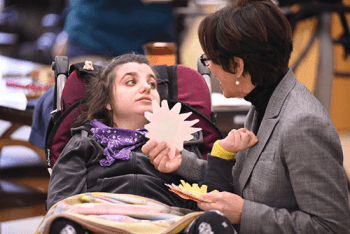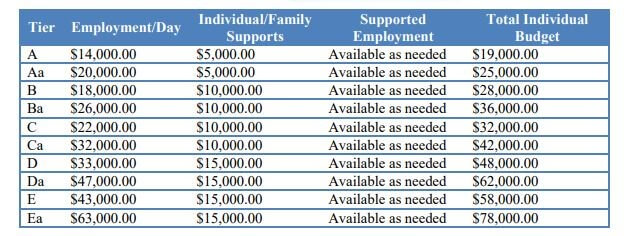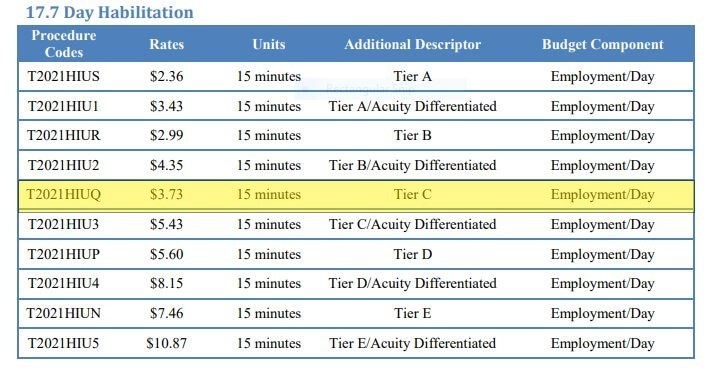DDD Programs Fund Services for Adults with Developmental Disabilities

Part One: The Supports Program
In New Jersey, services and support for adults with developmental disabilities are primarily funded through the Division of Developmental Disabilities (DDD). DDD is in the process of rolling all of the services that they provide from their previous contract-based system into a Medicaid-based Fee-for-Service system. In order to be eligible for DDD funded services, all individuals enrolled in the DDD system of supports and services must now be Medicaid eligible. To be eligible an individual must also be a New Jersey resident and meet the criteria of having a developmental disability.
To apply for services, an individual* must complete the DDD Intake Application and provide the required supporting documentation. After this preliminary paperwork is reviewed, the individual will be referred to the Developmental Disabilities Planning Institute (DDPI) who will assist them with completing a NJCAT (NJ Comprehensive Assessment Tool). Information acquired through the completion of the NJCAT will determine the amount of funding received or “Tier” to which an individual will be assigned. After a review of all of the data, individuals will receive written notification of their eligibility for one of two programs – the Supports Program or the Community Care Program.
The Supports Program
After being determined eligible, individuals who wish to utilize the services available in the Supports Program must first choose a Support Coordination Agency. A helpful booklet – Selecting a Support Coordination Agency – may assist individuals with this process. A Support Coordinator will then be assigned to them and is responsible for assisting the individual with planning and making necessary connections with services and resources. DDD case managers used to be the primary link between individuals and DDD services. In this new system, Support Coordinators provide that vital link.
The Tier that the individual was assigned to corresponds to a level of funding based on functional and support needs. This funding, or individual budget, will provide the resources that the individual can utilize when choosing or accessing services. The following chart shows the funding amounts available in the various tiers. Note that additional funding is available for individuals needing extra support in order to pursue or engage in employment (Supported Employment).
Support Program Budgets

In the Supports Program, individual Budgets can be spent on the following services:
- Assistive Technology
- Behavioral Supports
- Career Planning
- Cognitive Rehabilitation
- Community Based Supports
- Community Inclusion Services
- Day Habilitation
- Environmental Modifications
- Good and Services
- Interpreter Services
- Natural Supports Training
- Occupational Therapy
- Physical Therapy
- Prevocational Training
- Respite
- Speech, Language, and Hearing Therapy
- Support Employment
- Transportation
- Vehicle Modification
For more detailed information on these services, please refer to The Support Program Policies and Procedures Manual: A Quick Guide for Families (page 16). For a more detailed analysis, information on provider qualifications, service limits, policies, and rates, please refer to the more extensive Supports Program Policies & Procedures Manual (Version 5.0).
In the former system of services, providers were contracted to provide a service to a specific number of individuals in a program. In the new system, the individual basically “purchases” a service from a provider or vendor at an established rate. The rate or cost of that service will need to fit within the parameters of the individual’s budget. The Support Coordinator will work with the individual to determine how to best meet their needs with the funding available to them. But, it is helpful for individuals to enter this new way of accessing services with a basic understanding of the rate structure that affects and guides the use of all services.
Each of the services available in the Supports Program (see list above) has a specific code, rate, unit, and budget component assigned to it. It sounds very complicated……and it is. Walking through an example of may help. We’ll look at an individual with a Tier of C attending a day program (called Day Habilitation now). Here are the specific codes, rates, etc. for the Day Habilitation service:

Looking at the columns in the chart:
- Procedure Codes is the billing code that the provider uses to identify to Medicaid what service they provided. (This is like the billing codes your doctor uses to tell your insurance company what type of exam or procedure he provided for you.)
- Rates is the approved amount that Medicaid will pay the provider for that service
- Units is the specific amount of time the rate pays for (15 minutes, daily, single, etc.)
- Descriptor identifies the Tier
- Budget Component is the part of the budget that can be used to pay for this service. (If you refer back to the chart on Support Program Tiers, you’ll see that there are two funded components to each budget – Employment/Day and Individual/Family Support)
Looking at the chart, we can see that for an individual with a Tier of C, utilizing Day Habilitation, the provider will be paid $3.73 for every 15 minutes that the individual attends that program. And, those monies will be paid out of the “Employment/Day” component of the individual’s budget.
Not every Supports Program service has a dollar amount rate specified. The rate for several services is noted as “reasonable and customary”. This allows the individual some flexibility when purchasing a service such as a Vehicle Modification or Assistive Technology. It also allows the individual to set the pay rate for a self-hired Direct Support Professional. There are some limitations and requirements associated with services that allow this flexibility in rate, and those details can be found in The Supports Program Policies and Procedures Manual (Section 17).
The shift to a Fee-for-Service system represents a dramatic shift in thinking from the program- based system that has been around for so many years. Funding individuals instead of programs provides flexibility for the individual. However, it also requires that the individual be more involved, make more decisions, and have a more in depth knowledge of how the system works. With a general understanding of how Supports Program budgets can be utilized, individuals will be able to frame realistic expectations of meeting support needs. Support Coordinators should be able to answer any questions that individuals have, advise on the most efficient and effective use of individual’s budgets, and provide information on additional resources. (An individual/family having difficulty working with their Support Coordinator should contact their Support Coordination Agency or request an agency change by submitting a Support Coordination Agency Selection Form.)
For more information about the Supports Program, individuals should contact the DDD Community Service Office that serves their county (In Sussex County, it’s the Flanders office, 973-927-2600). Or, questions can be directed to the Supports Program Help Desk: [email protected].
Individuals who need higher levels of support or who wish to move out of the family home will need higher budgets than the Supports Program provides. The Community Care Program provides larger budgets for all Tiers. There is a waiting list for this program. For more information – Part Two of this blog – The Community Care Program – will be posted in July.
*For expediency, the term “individual” is used here. Many individuals will need the assistance of a family member or other authorized person to assist them with applying for, accessing, and managing services.



